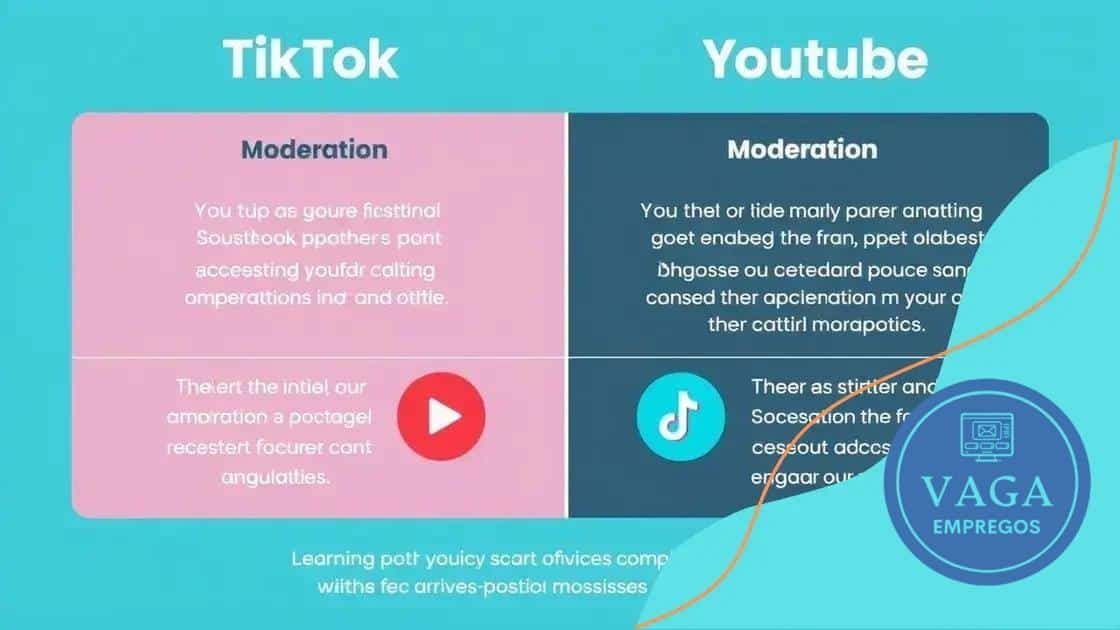TikTok and YouTube tighten content moderation policies

Advertisement
TikTok and YouTube are tightening content moderation policies by utilizing artificial intelligence and community involvement to create safer environments while enabling creators to adapt their content strategies effectively.
TikTok and YouTube tighten content moderation policies as platforms aim for a safer environment against misinformation and harmful content. Have you noticed how these changes affect your favorite creators?
Advertisement
Understanding content moderation changes
Understanding content moderation changes is crucial in today’s digital landscape. Platforms like TikTok and YouTube are tightening their rules to create a safer user environment. These changes are significant for both creators and viewers.
Advertisement
First, let’s look at how TikTok is adjusting its policies. The platform has been under scrutiny for various content issues, prompting it to enhance its moderation techniques. Now, it focuses on preventing harmful content from appearing on user feeds. This shift not only affects the type of videos that can go viral but also influences how creators engage with their audiences.
Key Changes on TikTok
- Stricter guidelines on hate speech and misinformation.
- Enhanced algorithms to detect inappropriate content faster.
- Increased transparency in community guidelines.
- Collaboration with fact-checkers to verify information.
Similarly, YouTube has ramped up its efforts to manage content more effectively. With a vast amount of uploads daily, moderation is a challenge. However, the emphasis on user safety is leading to innovative practices.
Changes in YouTube’s Approach
One noteworthy aspect is how YouTube implements its content moderation through advanced machine learning techniques. This ensures that inappropriate content is flagged quickly. Additionally, the platform is meticulous about feedback from users to adjust its policies continually.
This development can lead to a significant impact on creators looking to monetize their content. As the rules become more defined, understanding what is permissible becomes vital for all parties involved. For instance, creators now have to be more cautious about the messages they convey, fearing potential penalties for violations.
- Increased emphasis on ad-friendly content.
- Regular updates to creators about changing policies.
- More direct communication channels for addressing concerns.
Finally, as these content moderation changes unfold, they are shaping the future of how content is created and consumed online. Both platforms strive to balance creative freedom with user protection, setting a precedent that other platforms may follow.
The impact on creators’ freedom

The content moderation policies on platforms like TikTok and YouTube significantly affect creators’ freedom. As these rules tighten, creators must adapt to new expectations and guidelines. These changes may pose challenges, but they also encourage more responsible content creation.
On TikTok, the shift towards stricter content moderation means that creators are now required to be more cautious about the material they post. The platform’s algorithms are designed to identify potentially harmful content quickly. This means that any video that strays too far from community guidelines risks being removed or demonetized.
Changes Influencing Creative Expression
As the guidelines evolve, many creators feel they are losing their artistic edge. Some essential aspects include:
- The need to remove controversial topics from their content.
- Adjusting styles to fit within a more defined narrative.
- A decrease in spontaneous content that drives engagement.
- Balancing personal expression with audience safety concerns.
This situation extends to YouTube as well. With its emphasis on maintaining a safe environment for viewers, the platform has introduced policies aimed at reducing inappropriate content. While this is beneficial for users, many creators express their concerns over restricted creativity.
Finding a New Balance
To be successful, creators must now navigate these changes strategically. They are continuously seeking ways to maintain their unique voices while adhering to strict rules. For example, some choose to focus on positive and uplifting messages to ensure compliance. This approach not only helps meet guidelines but also resonates well with audiences.
In contrast, others are experimenting with different formats that allow them to express their viewpoints creatively while staying within the lines. By embracing innovation, creators can adapt to the new norm without compromising their core messages. Engaging storytelling is becoming a vital tool for connecting with viewers in this changing landscape.
- Encouraging healthy discussions through storytelling.
- Embedding educational content that meets guidelines.
- Adapting humor while avoiding sensitive topics.
In summary, creators’ freedom is evolving as social media platforms implement stricter content policies. By understanding these changes and adjusting their strategies, creators can still thrive in a dynamic and challenging environment.
User safety and community guidelines
User safety and community guidelines are essential components for platforms like TikTok and YouTube. As these platforms evolve, they focus increasingly on creating a safe environment. The guidelines are designed to protect users from harmful content while promoting a positive online experience.
The implementation of these guidelines involves thorough checks on what can be shared. For instance, both platforms work actively to screen content that may involve hate speech or misinformation. This ensures that communities feel secure while interacting with each other.
Importance of Community Guidelines
Community guidelines serve several crucial purposes:
- Preventing the spread of harmful or misleading content.
- Encouraging respectful interactions among users.
- Providing a clear framework for acceptable behavior.
- Enabling users to report violations effectively.
These rules help maintain a positive atmosphere. Users are encouraged to engage in constructive interactions, knowing that there are consequences for violations. With robust reporting systems in place, users can easily report content that doesn’t meet community standards.
Protecting Vulnerable Users
Another important aspect of user safety is the protection of vulnerable groups. Both TikTok and YouTube are working to ensure that their platforms are welcoming for all users, especially children and teens. This includes implementing age restrictions on certain content and providing parental controls.
In recent updates, both platforms have introduced features aimed at reducing cyberbullying. For example, tools that allow users to filter out negative comments have been made more accessible. This empowers creators to cultivate healthier interactions with their audience.
- Enhanced privacy settings for younger users.
- In-app resources for reporting bullying behavior.
- Collaborations with organizations that promote online safety.
It’s crucial for platforms to continuously refine these guidelines. By evolving their policies around user safety, both TikTok and YouTube aim to create a more enjoyable environment for everyone. This ongoing effort requires collaboration between the platforms and their communities to ensure that safety standards remain high.
Comparative analysis of TikTok and YouTube policies

Comparative analysis of TikTok and YouTube policies reveals how these popular platforms approach content moderation. While both aim to create safe environments, their methods and guidelines differ significantly, impacting the way creators generate content.
First, let’s examine TikTok. The platform has developed policies that focus on user-generated content and its potential risks. For TikTok, the moderation process emphasizes real-time monitoring of videos to prevent harmful content from spreading. Unlike YouTube, TikTok uses a combination of artificial intelligence and human reviewers to quickly identify and remove content that violates community guidelines.
Key Features of TikTok’s Policies
Some core aspects include:
- Immediate response to flagged content.
- Emphasis on user engagement in reporting.
- Continuous updates to community guidelines based on user behavior.
- Increased focus on trends that may promote negative content.
In contrast, YouTube has a more established framework for managing content. The platform allows longer videos and a different style of engagement. YouTube employs a system where users can appeal decisions regarding content removal, creating a dialogue between creators and the platform.
Features of YouTube’s Policies
Some distinctive elements include:
- A well-defined appeals process for creators.
- Detailed guidelines on content monetization.
- Community posts to inform users about updates and changes.
- Collaborations with external organizations for better guideline implementation.
Both platforms are keen on enhancing user safety while providing clear rules for content creators. TikTok’s fast-paced environment requires quick adjustments to policies, while YouTube’s well-established guidelines reflect its broader content scope. Despite their differences, both strive to support their communities and encourage responsible content creation.
Furthermore, these policy comparisons highlight an important trend: the need for platforms to adapt continuously. Content moderation is not a one-size-fits-all approach, and each platform must tailor its policies to suit the unique dynamics of its user base. As trends change, these platforms will need to remain vigilant in updating their guidelines.
Future trends in content moderation
Future trends in content moderation are shaping how platforms like TikTok and YouTube will manage content in the coming years. As technology evolves, so do the strategies for keeping users safe and ensuring a positive online experience.
One of the most significant trends is the increasing use of artificial intelligence in moderation processes. This technology allows platforms to analyze vast amounts of data quickly. AI can identify patterns and flag potentially harmful content more efficiently than human moderators alone. This shift means that moderation can happen in real-time, reducing the exposure of users to inappropriate material.
Emerging Technologies in Moderation
As AI technology improves, several key features are expected to enhance moderation:
- Advanced algorithms for better context understanding.
- Automated responses to user reports to speed up resolution.
- Predictive analysis to foresee problematic content before it goes viral.
- Enhanced user controls for customizing content visibility.
Moreover, employing machine learning can enable moderators to adapt guidelines based on user feedback and current trends. By learning from past decisions, these systems can continually improve.
Community Involvement
Another trend is the push for community involvement in content moderation decisions. Social media platforms are recognizing that users play a crucial role in maintaining a safe environment. For example, features that allow users to collaboratively flag inappropriate content can enhance accountability.
Moreover, platforms are starting to seek feedback from users about their experiences with moderation decisions. This practice not only builds trust but also allows for more tailored and effective guidelines. When users feel empowered, they are more likely to engage positively with the community.
- Encouraging users to participate in creating and refining guidelines.
- Implementing user-driven reporting systems.
- Building forums for users to discuss moderation practices.
The future of content moderation will likely involve a combination of cutting-edge technology and user-centric approaches. Through collaborations and innovations, platforms aim to create an environment that prioritizes safety while allowing for creative expression. As trends continue to evolve, staying informed and adaptable will be critical for both users and creators.
FAQ – Frequently Asked Questions About Content Moderation on TikTok and YouTube
What is content moderation and why is it important?
Content moderation involves monitoring and managing user-generated content to ensure it adheres to community guidelines, promoting a safe and healthy online environment.
How do AI tools enhance content moderation?
AI tools can analyze large volumes of content quickly, identifying and flagging potentially harmful material before it reaches users, ultimately improving responsiveness and safety.
What role does community feedback play in moderation policies?
Community feedback is vital for shaping effective moderation policies, as it helps platforms understand user concerns and make necessary adjustments to guidelines.
How can content creators navigate stricter moderation policies?
Content creators can adapt by understanding the new guidelines, focusing on positive messaging, and exploring innovative content formats that align with the policies.





